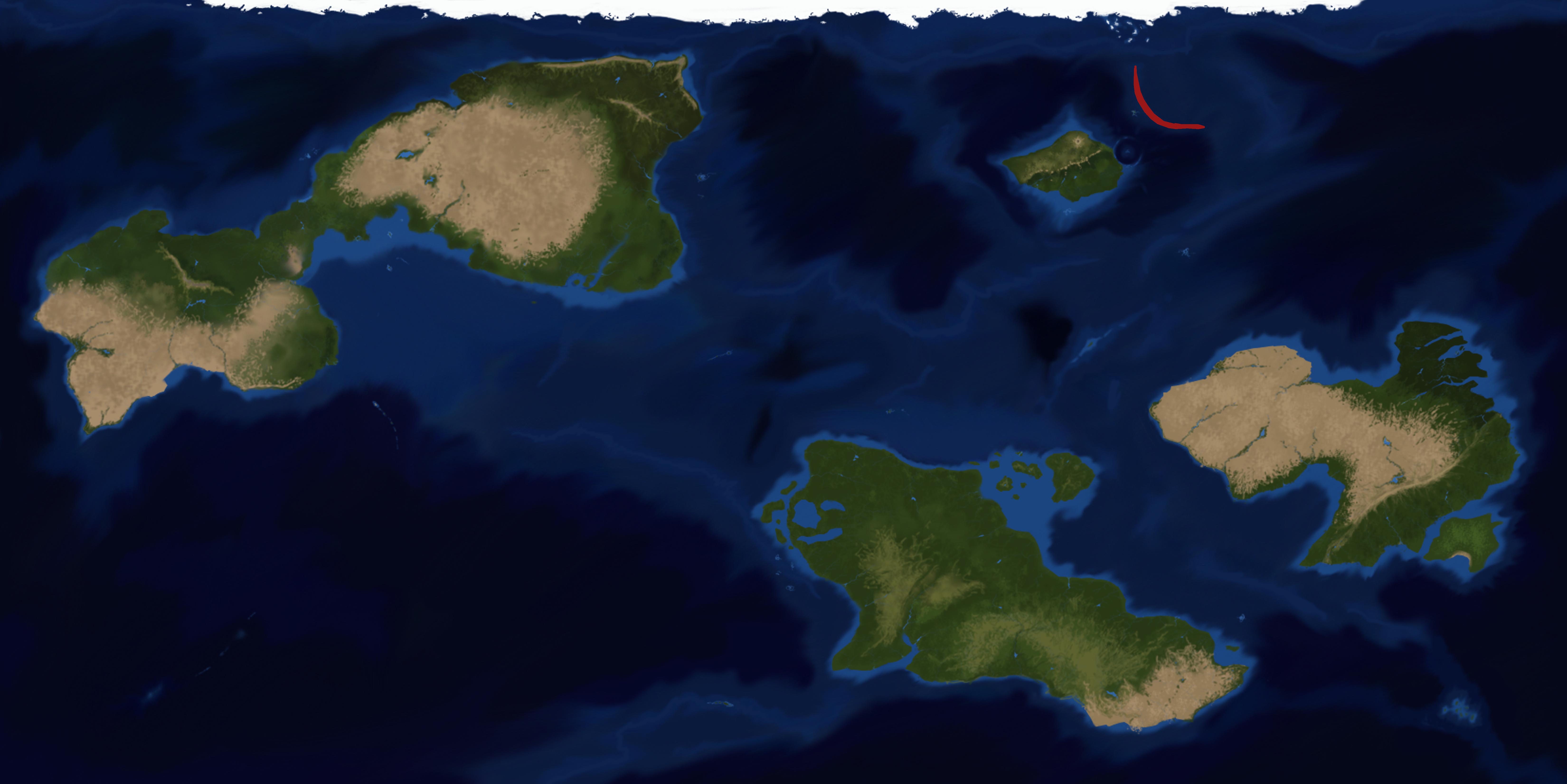Grinning Devil
Caudocephalichthys misteriosa is an abyssal amphibian from the Nova Trench, found east of the continent of Gleann Blathànna.
This animal, endemic to the trench, lives at depths of 9000 m or more, near the bottom, making it among the deepest living organisms ever discovered on the planet.
as many of the creatures inhabiting this environment, it remains quite concealed and moves only seldomly and with slow movements to save energy.
The species makes characteristic clicks by opening and closing its mouth rapidly; as of today the consensus is that this sound is used to lure prey in as it’s vaguely similiar to the pincers of a sandcreeper closing.
The animal hunts mostly by staying still in the water column near hydrothermal vents, an ideal spot for hunting large amounts of small ichthyomorphs and pleuropods.
The apex predator has been observed hunting anything ranging from smaller ichthyomorphs, pleuropods and invertebrates like sandcreepers and trawlers.
The long barb coming down from the chin is able to send bioluminescent signals to nearby conspecifics, primary method this animal uses for intraspecific communication, as observed by a TWPP expedition in the southern region of the trench in 2471.
Most of what we know about this animal has been recorded in the Watson’s Marine Biology Research Center, Gleann Blathànna, where the only captive specimen to survive was kept in a hyperbaric tank up to its premature death for radiation exposure a few months after its transport.
Basic Information
Anatomy
- Cranium with protruding rostrum, creating a horn like structure on the head; cranial armor thick with ample segmentation; fleshy barb on the ventral section of the jaw; gum exposed; maxillasemicircular with long and thin teeth,
- Body elongated with no clear visual distinction between thorax and gill tail.
- Fins underdeveloped, thick and fleshy.
- Gill fan with low ridges and soft caudal drop; proper tail extending after the caudal drop's end.
Genetics and Reproduction
Not known.
Further research in the field is scheduled with the next exploration of the area departing December of 2581.
Growth Rate & Stages
Younger specimens estimated up to two years old still possess the natal aculeus.
Very young individuals have larger fins and a more segmented cranial armour, hinting at an ancestry with a much more segmented dermocranial covering.
Ecology and Habitats
Caudocephalichthys misteriosa is a Hadalpelagic animal endemic of the Nova Trench; they can be found living at depths from 9,000 m onwards, near and at the bottom of the trench.
They can be found idle near hydrothermal vents, probably absorbing heat from their activity and for hunting purposes.
Dietary Needs and Habits
These animals feed on smaller amphibians, pleuropods and invertebrates they attract by clicking with their mouth, mimicking the sound of Sandcreeper pincers closing.
Biological Cycle
Through the observation of the handful of specimens ever recorded we know these animals grow slowly, losing their natal aculeus sometime after their second year of age.
Although we don't know the age at which they mature, we know that, thanks to their extremely low metabolic rates, they can live for long periods of time without feeding.
We also know these animals to be extremely enduring, with a recorded specimen estimated to be almost two hundred years old.
Additional Information
Social Structure
They live in small groups loose in a single area.
They communicate through green light bioluminescence coming from the fleshy barb on the chin.
Uses, Products & Exploitation
Only one specimen managed to survive transport to Watson’s Marine Biology Research Center (WMBRC), giving us ample information on the species through observation in a specialized tank.
The animal died three months later due to radiation exposure coming from the atmosphere, condition to which abyssal ichthyomorphs are not used to anymore.
Geographic Origin and Distribution
Perception and Sensory Capabilities
They use echolocation and sight for movement; like many other animals on the planet, they are able to synthetize particular kinds of photosynthetic molecules in the eyes to allow them to perceive different light wavelenghts in the depths, making them able to communicate with each other using bioluminescence and see prey in the otherwise pitch black waters of the midnight zone.
This particular species emits green light, the most common among the wavelengths used in the abyssal areas.
The specific shape, movement, hue and rhythm of the bioluminescent signals define to which individual they come from.
Scientific Name
Eoichthyia; Tartarosomnia; Rotunducephalidae; Gladiopinneoidea; Paragladioidea; Caudocephalidae ; Caudocephalinae; Caudocephalichthys; C. misteriosa
Lifespan
200+ years
Conservation Status
DATA DEFICENT: not enough information to properly assess this animal's status.
Population trend: UNKNOWN
Average Weight
30 to 60 kg
Body Tint, Colouring and Marking
Brown body tint with reddish fins and dark grey armor.
Remove these ads. Join the Worldbuilders Guild












Comments